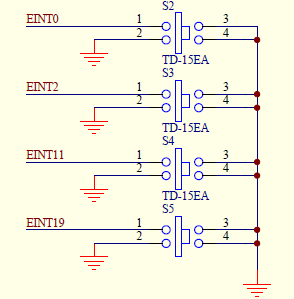在Linux驱动之LED驱动编写已经详细介绍了一个驱动的编写过程,接着来写一个按键驱动程序,主要是在file_operations结构中添加了一个read函数。还是分以下几步说明
5、编写Makefile,编译驱动代码与测试代码,在开发板上运行
打开原理图,确定需要控制的IO端口为GPF0、GPF2、GPG3、GPG11

2、查看芯片手册,确定IO端口的寄存器地址,可以看到因为用了两组GPIO端口,所以它的基地址分别为0x56000050、0x56000060


1)、编写出口、入口函数。代码如下,具体说明参考Linux驱动之LED驱动编写
static int second_drv_init(void) { Secondmajor = register_chrdev(0, "buttons", &second_drv_ops);//注册驱动程序 if(Secondmajor < 0) printk("failes 1 buttons_drv register "); second_drv_class = class_create(THIS_MODULE, "buttons");//创建类 if(second_drv_class < 0) printk("failes 2 buttons_drv register "); second_drv_class_dev = class_device_create(second_drv_class, NULL, MKDEV(Secondmajor,0), NULL,"buttons");//创建设备节点 if(second_drv_class_dev < 0) printk("failes 3 buttons_drv register "); gpfcon = ioremap(0x56000050, 16);//重映射 gpfdat = gpfcon + 1; gpgcon = ioremap(0x56000060, 16);//重映射 gpgdat = gpgcon + 1; printk("register buttons_drv "); return 0; } static void second_drv_exit(void) { unregister_chrdev(Secondmajor,"buttons"); class_device_unregister(second_drv_class_dev); class_destroy(second_drv_class); iounmap(gpfcon); iounmap(gpgcon); printk("unregister buttons_drv "); } module_init(second_drv_init); module_exit(second_drv_exit);
2)、添加file_operations 结构体,这个是字符设备驱动的核心结构,所有的应用层调用的函数最终都会调用这个结构下面定义的函数
static struct file_operations second_drv_ops = { .owner = THIS_MODULE, .open = second_drv_open, .read = second_drv_read, };
3)、分别编写file_operations 结构体下的open、read函数。其中open函数主要将相应的IO端口配置成输入功能,read函数主要是读出IO端口的高低电平,然后传给应用程序处理。函数为copy_to_user,第一个参数为目标地址(即传到应用层的地址),第二个参数位源地址(即在内核里的地址),第三个参数为传的个数。
static int second_drv_open (struct inode * inode, struct file * file) { /*配置gpf0、gpf2 io端口为输入*/ *gpfcon &= ~((3<<(0*2)) | (3<<(2*2))); /*配置gpg3、gpg11 io端口为输入*/ *gpgcon &= ~((3<<(3*2)) | (3<<(11*2))); return 0; } static ssize_t second_drv_read(struct file * file, char __user * userbuf, size_t count, loff_t * off) { unsigned char key_values[4]; unsigned long key_value; int ret; if(count != sizeof(key_values)) { printk("read error "); return -1; } /*读取gpf0、gpf2 io端口*/ key_value = *gpfdat; key_values[0] =( (key_value>>0)&0X01) ? 1:0; key_values[1] =( (key_value>>2)&0X01) ? 1:0; /*读取gpg3、gpg11 io端口*/ key_value = *gpgdat; key_values[2] =( (key_value>>3)&0X01) ? 1:0; key_values[3] =( (key_value>>11)&0X01) ? 1:0; ret = copy_to_user(userbuf, key_values, sizeof(key_values)); if(ret) { printk("copy error "); return -1; } return sizeof(key_values); }
4)、整体代码
#include <linux/module.h> #include <linux/kernel.h> #include <linux/fs.h> #include <linux/init.h> #include <asm/io.h> //含有iomap函数iounmap函数 #include <asm/uaccess.h>//含有copy_from_user函数 #include <linux/device.h>//含有类相关的处理函数 static struct class *second_drv_class;//类 static struct class_device *second_drv_class_dev;//类下面的设备 static int Secondmajor; static unsigned long *gpfcon = NULL; static unsigned long *gpfdat = NULL; static unsigned long *gpgcon = NULL; static unsigned long *gpgdat = NULL; static int second_drv_open (struct inode * inode, struct file * file) { /*配置gpf0、gpf2 io端口为输入*/ *gpfcon &= ~((3<<(0*2)) | (3<<(2*2))); /*配置gpg3、gpg11 io端口为输入*/ *gpgcon &= ~((3<<(3*2)) | (3<<(11*2))); return 0; } static ssize_t second_drv_read(struct file * file, char __user * userbuf, size_t count, loff_t * off) { unsigned char key_values[4]; unsigned long key_value; int ret; if(count != sizeof(key_values)) { printk("read error "); return -1; } /*读取gpf0、gpf2 io端口*/ key_value = *gpfdat; key_values[0] =( (key_value>>0)&0X01) ? 1:0; key_values[1] =( (key_value>>2)&0X01) ? 1:0; /*读取gpg3、gpg11 io端口*/ key_value = *gpgdat; key_values[2] =( (key_value>>3)&0X01) ? 1:0; key_values[3] =( (key_value>>11)&0X01) ? 1:0; ret = copy_to_user(userbuf, key_values, sizeof(key_values)); if(ret) { printk("copy error "); return -1; } return sizeof(key_values); } static struct file_operations second_drv_ops = { .owner = THIS_MODULE, .open = second_drv_open, .read = second_drv_read, }; static int second_drv_init(void) { Secondmajor = register_chrdev(0, "buttons", &second_drv_ops);//注册驱动程序 if(Secondmajor < 0) printk("failes 1 buttons_drv register "); second_drv_class = class_create(THIS_MODULE, "buttons");//创建类 if(second_drv_class < 0) printk("failes 2 buttons_drv register "); second_drv_class_dev = class_device_create(second_drv_class, NULL, MKDEV(Secondmajor,0), NULL,"buttons");//创建设备节点 if(second_drv_class_dev < 0) printk("failes 3 buttons_drv register "); gpfcon = ioremap(0x56000050, 16);//重映射 gpfdat = gpfcon + 1; gpgcon = ioremap(0x56000060, 16);//重映射 gpgdat = gpgcon + 1; printk("register buttons_drv "); return 0; } static void second_drv_exit(void) { unregister_chrdev(Secondmajor,"buttons"); class_device_unregister(second_drv_class_dev); class_destroy(second_drv_class); iounmap(gpfcon); iounmap(gpgcon); printk("unregister buttons_drv "); } module_init(second_drv_init); module_exit(second_drv_exit); MODULE_LICENSE("GPL");
测试程序实现四个按键中有一个按键按下时,打印出四个按键的按键值。./sencond_test。直接看代码
#include <sys/types.h> #include <sys/stat.h> #include <fcntl.h> #include <stdio.h> /* *usage ./buttonstest */ int main(int argc, char **argv) { int fd; char* filename="dev/buttons"; unsigned char key_val[4]; unsigned long cnt=0; fd = open(filename, O_RDWR);//打开dev/firstdrv设备文件 if (fd < 0)//小于0说明没有成功 { printf("error, can't open %s ", filename); return 0; } if(argc !=1) { printf("Usage : %s ",argv[0]); return 0; } while(1) { read(fd, key_val, sizeof(key_val)); if(!key_val[0] || !key_val[1] || !key_val[2] || !key_val[3]) printf("%d key pressed %d %d %d %d ",cnt++,key_val[0],key_val[1],key_val[2],key_val[3]); } return 0; }
5、编写Makefile,编译驱动代码与测试代码,在开发板上运行
Makefile源码如下:
KERN_DIR = /work/system/linux-2.6.22.6 all: make -C $(KERN_DIR) M=`pwd` modules //M='pwd'表示当前目录。这句话的意思是利用内核目录下的Makefile规则来编译当前目录下的模块 clean: make -C $(KERN_DIR) M=`pwd` modules clean rm -rf modules.order obj-m +=sencond_drv.o//调用内核目录下Makefile编译时需要用到这个参数
1)、然后在当前目录下make后编译出second_drv.ko文件
2)、arm-linux-gcc -o second_test second_test.c编译出second_test测试程序
3)、cp second_drv.ko second_test /work/nfs_root将编译出来的文件拷贝到开发板挂接的网络文件系统上
4)、执行insmod second_drv.ko加载驱动。
5)、./second_test测试程序,按下按键,成功打印按键值,用top命令查看应用程序发现second_test程序占用了99%的CPU资源,这个驱动程序还需要完善。
